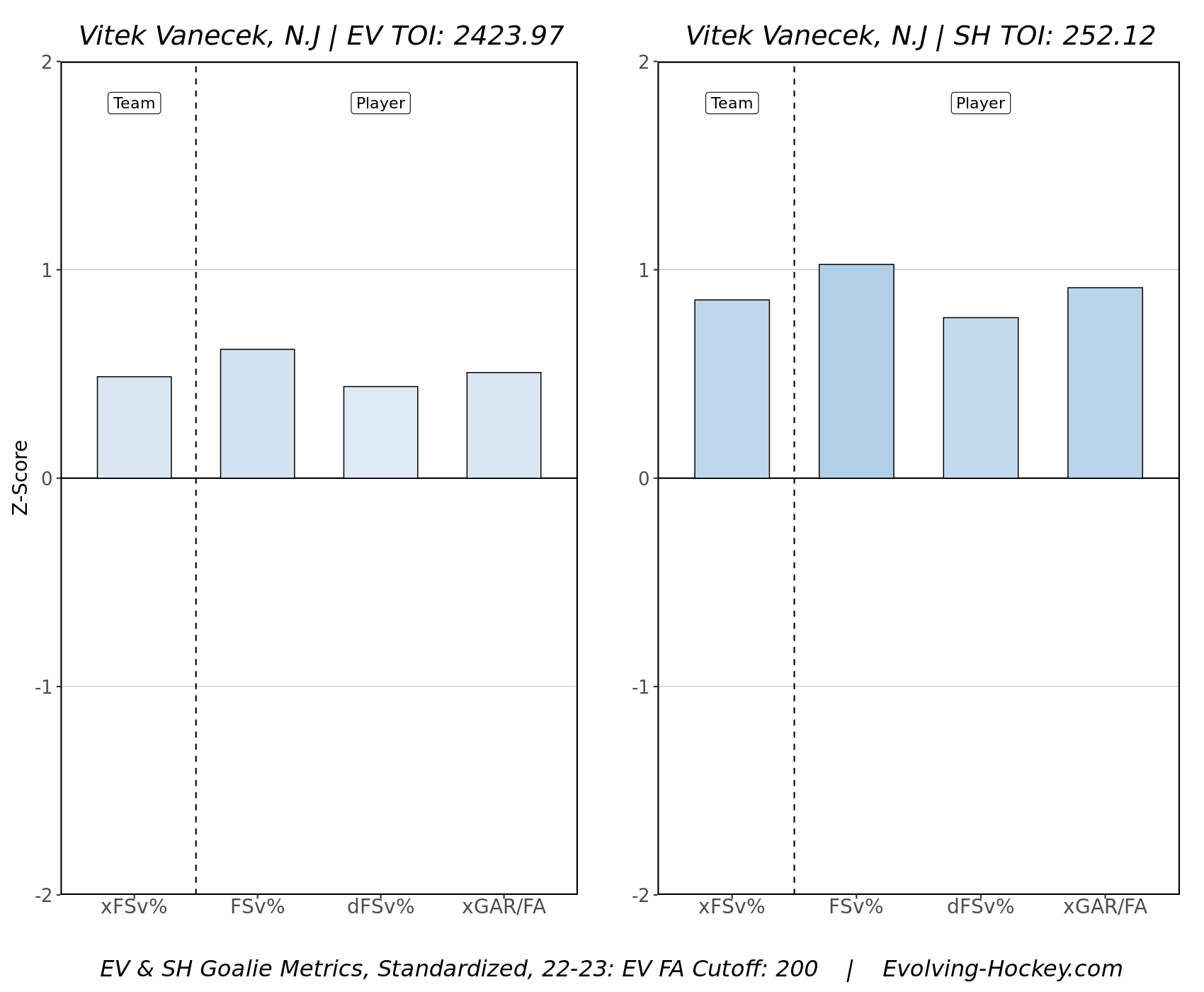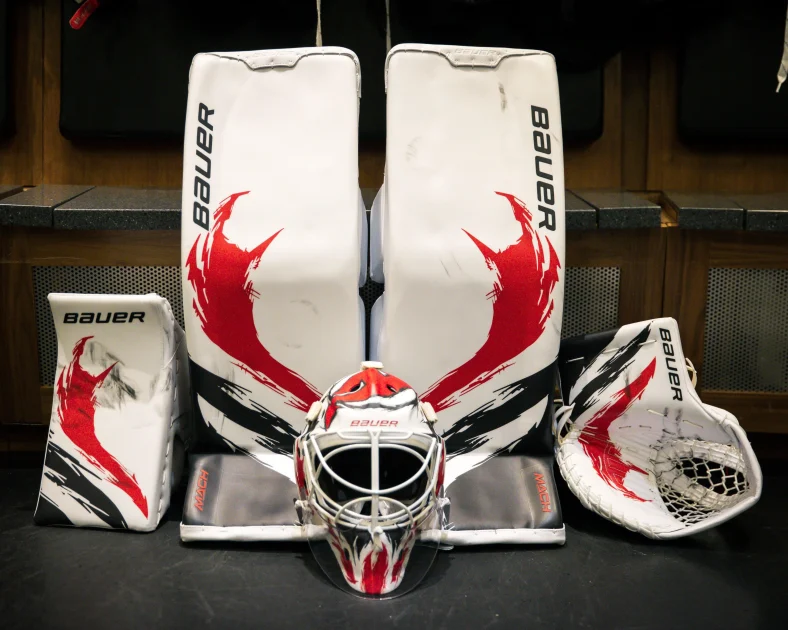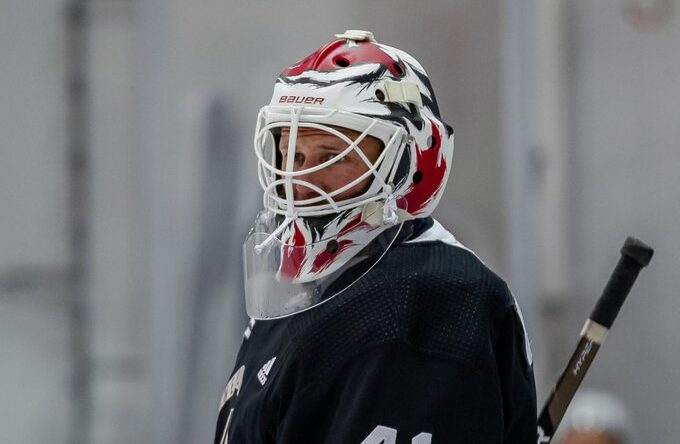
Happy playoffs BSB faithful. It’s been a bit since you’ve last heard from me, but I thought the time was right to stop by and offer some analysis on the Rangers’ goaltending matchup for the first round with this Vitek Vanecek style report. The Rangers’ date with the Devils fulfills the expectation that was seemingly set in stone months ago, but bizarrely was only confirmed late last week. Hockey is a strange sport sometimes.
After years of fairly unreliable goaltending, the Devils looked to a steadier performer in Vitek Vanecek to give them at least league-average goaltending this season. The 27-year-old Czech has been a metronome in his first three NHL seasons, carrying save percentages between .908 and .911 in each of those years. He was exactly what the Devils were hoping for to stabilize their young and talented squad, but will it be enough to get them past the Rangers in round 1? Let’s break it down.
Stance
Let’s start with Vanecek’s overall set up. He has a fairly wide stance, with an upper body posture that I informally refer to as a “hulking” stance. It’s not all that dissimilar to James Reimer or J.S. Giguere in posture. The unique aspect is that Vanecek’s shoulder points are facing between straight forward and down, which causes the goalie to use their arms for width, rather than their chest.
This posture makes it easy to compress your core, which can help with staying compact fighting through traffic or exploding laterally, but it leads to balance challenges.
When your shoulders are rolled back and your chest puffed out, it’s easier to keep your weight moving upward, which keeps you lighter on your feet and better balanced. When your weight is pushing forward and down, you can’t fight gravity as effectively and you tend to collapse on lateral plays, making recovery more difficult.
For goaltenders that use this, the only explanation I have is that they are simply more comfortable with this posture, as it provides no meaningful advantage in executing save techniques.
Crease Movement/Depth
What helps Vanecek overcome these structural disadvantages is that he is a gifted athlete. He is able to overcome some of the technical deficiencies in his game with athleticism and movement. He has powerful lateral pushes and active gloves, which helps cover distance on higher danger chances. He is a battler in the crease and is rarely out of a play, leading to some ridiculous highlight reel saves.
However, he does have a tendency to over-move and pull himself out of position more often than he should. (Think a less insanely athletic Jonathan Quick). There is definitely another gear that Vanecek could unlock if he could commit to a more technical and disciplined game, rather than relying so heavily on his athletic ability.
He also tends to play a little higher out in the crease than many of his modern counterparts. We’ve seen the pendulum swing back from the “goal-line goaltending” days of Henrik Lundqvist, as there is real value in cutting down the angles from a bit higher out.
There is a point of diminishing returns, though, both in terms of how much angle you are taking away and how far from the net you take yourself. This is likely a big contributor to Vanecek’s wandering habit.
Performance
It’s a little strange that a goaltender with a suspect technical foundation can be that consistent, statistically. Looking under the hood a bit shows that he has arrived at his numbers in different ways each season*. In his rookie year, Vanecek was very good while playing shorthanded, but slightly below average at even strength.
The following season he was better at even strength, but worse on the penalty kill. Sticking with this theme, the Capitals ranked 11th and 12th in the league in those years on the PK, despite very different individual outcomes for Vanecek. This season he has been better in both categories, yet has similar rate stats such as GAA and Save % as he did in Washington. The improvement on the penalty kill makes sense in this context, as the Devils had the 4th best PK in the NHL this year.
From looking at his chart, one could draw the conclusion that in his age 27 season, Vanecek has taken that big step forward. However, looking at his GSAA stats playing for a high performing team, Vanecek was only middle of the pack, with a GSAA of 7.65 goals saved above average over 52 GP.
For comparison purposes, the Rangers largely performed at a comparable level to New Jersey over this season, with the only meaningful difference being success in OT/SO. We all know that Igor Shesterkin had a down season by his lofty standards, but he still outperformed Vanecek in GSAA, sporting 19.1 goals saved above average, albeit in six more games.
Since Vanecek has only played 3 seasons, it’s hard to draw any specific conclusions about his abilities against his statistics, but he seems to be consistent in spite of his inconsistencies.
Equipment
Adding the bag of contradictions, albeit of the much more subjective variety is Vanecek’s equipment. He wears one of the nicest custom designed sets I’ve seen in quite some time. In an updated homage to Martin Brodeur’s Heaton Helite IV set from the mid-90’s, Vanecek uses Bauer’s Mach line, which is their flagship stiff pad. He also has a very sharp Brodeur inspired paint job.
However, and I stress this is just personal preference, he chooses to wear a Bauer NME mask, which to me looks like an awkward fishbowl on the head. It’s wide where it should be narrow and creates a really strange face shape for the cage. Not for me, but kudos for a great set, overall.
Puck-Handling
I’m going to qualify this, as I haven’t found a lot of tape of Vanecek handling the puck. From what I can recall watching him live, he appears to be a competent and simple puck handler. He isn’t going to be a third defenseman back there, but he shouldn’t be turning the puck over recklessly either.
Exploitable Weaknesses
We’ve discussed a couple of exploitable weaknesses, thus far. Getting Vanecek to run around with the Devil’s sometimes suspect defense is a good recipe for success. However, the biggest weakness the Rangers can exploit is rebounds, especially on the powerplay.
Vanecek does not manage rebounds well and has a negative GSAA against high danger scoring chances. When you look at the logical correlation between bad rebounds and high danger scoring chances, the Rangers at times lethal powerplay could cause some fits.
Otherwise, these types of chances in sustained zone time could lead to better chances against weaker line matchups; with say the Kid Line being able to create additional zone possession or scoring chances if Vanecek can’t control rebounds and stop the play. Since the Rangers don’t want to get into a track meet with the smaller, faster Devils, exploiting rebound control issues and using it to increase zone possession or other havoc in front of the New Jersey net could definitely bear fruit.
Alternatively, since the Rangers do not style their offense around rebound chances, their passing abilities have the potential to pull Vanecek out of position regularly, given his proclivities toward over-moving. With a goaltender who is a technical wild card, there are always a number of avenues to pursue. The downside is that athleticism always has the ability to steal a series if you don’t bury your chances.
Vitek Vanecek style report conclusion
Short of the goaltending train wreck in Florida, Vancek might be the best goaltending matchup for the Rangers, on paper. While he is a very talented netminder, a less-than-technically-sound goaltender on a team whose defense is not all that well structured provides a number of opportunities to find an edge. Top that off with playoff inexperience and an all-world goaltender between the pipes for the Rangers, this matchup could be the difference between two very evenly matched teams.
However, as the old adage goes, be careful what you wish for.
*All stats via Evolving-Hockey
Share:
More About:Analysis Goaltending




